engine PEUGEOT 2008 2015 Manual Online
[x] Cancel search | Manufacturer: PEUGEOT, Model Year: 2015, Model line: 2008, Model: PEUGEOT 2008 2015Pages: 340, PDF Size: 8.4 MB
Page 213 of 340
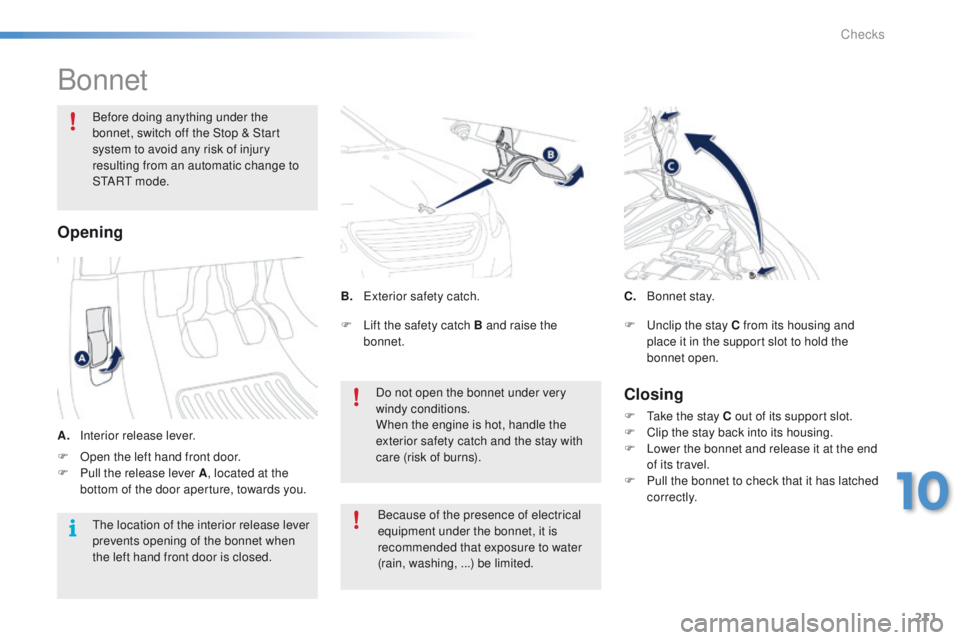
211
2008_en_Chap10_verifications_ed01-2015
Bonnet
Before doing anything under the
bonnet, switch off the Stop & Start
system to avoid any risk of injury
resulting from an automatic change to
S TA R T m o d e .
Closing
F Take the stay C out of its support slot.
F C lip the stay back into its housing.
F
L
ower the bonnet and release it at the end
of its travel.
F
P
ull the bonnet to check that it has latched
c o r r e c t l y.
F
L
ift the safety catch B and raise the
bonnet.
Do not open the bonnet under very
windy conditions.
When the engine is hot, handle the
exterior safety catch and the stay with
care (risk of burns).
Opening
B. Exterior safety catch.
A.
I
nterior release lever. Because of the presence of electrical
equipment under the bonnet, it is
recommended that exposure to water
(rain, washing, ...) be limited.
The location of the interior release lever
prevents opening of the bonnet when
the left hand front door is closed. C. B
o n n et st ay.
F
U
nclip the stay C from its housing and
place it in the support slot to hold the
bonnet open.
F
O
pen the left hand front door.
F
P
ull the release lever A , located at the
bottom of the door aperture, towards you.
10
Checks
Page 214 of 340
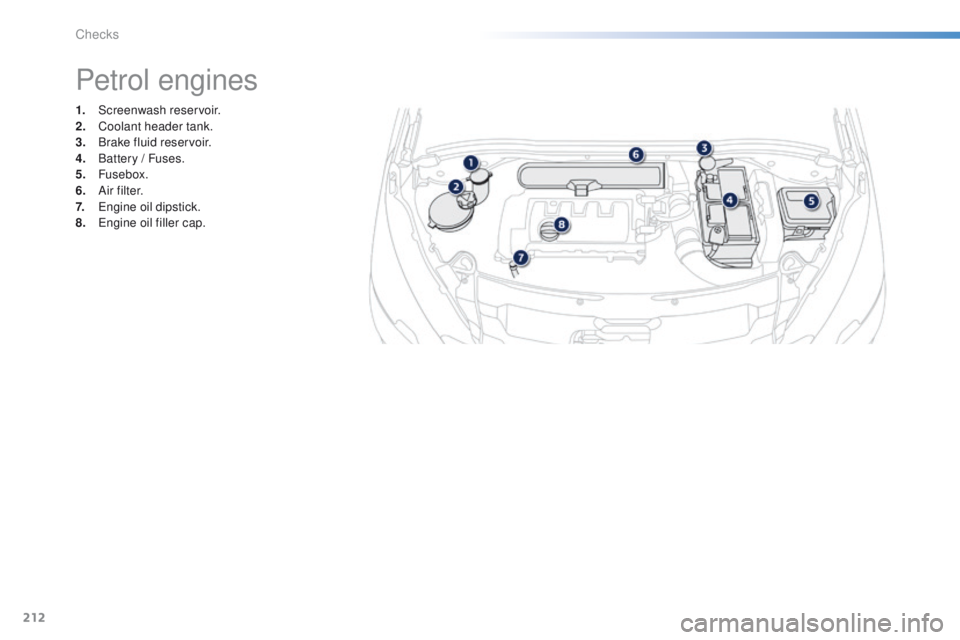
212
2008_en_Chap10_verifications_ed01-2015
1. Screenwash reservoir.
2. Coolant header tank.
3.
B
rake fluid reservoir.
4.
B
attery / Fuses.
5.
Fusebox.
6.
A
i r f i l t e r.
7.
E
ngine oil dipstick.
8.
E
ngine oil filler cap.
Petrol engines
Checks
Page 215 of 340
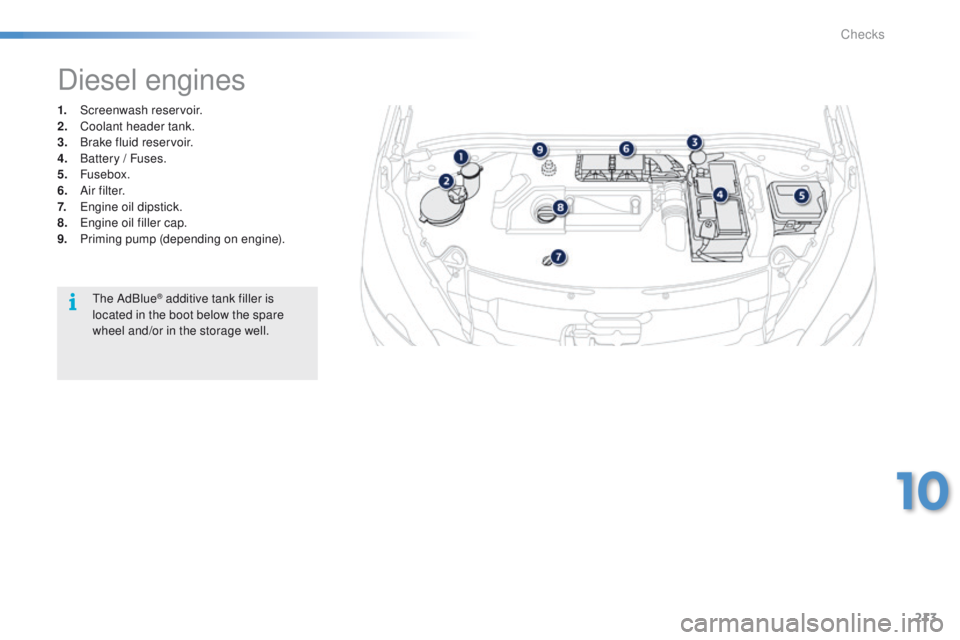
213
2008_en_Chap10_verifications_ed01-2015
1. Screenwash reservoir.
2. Coolant header tank.
3.
B
rake fluid reservoir.
4.
B
attery / Fuses.
5.
Fusebox.
6.
A
i r f i l t e r.
7.
E
ngine oil dipstick.
8.
E
ngine oil filler cap.
9.
P
riming pump (depending on engine).
Diesel engines
The AdBlue® additive tank filler is
located in the boot below the spare
wheel and/or in the storage well.
10
Checks
Page 216 of 340
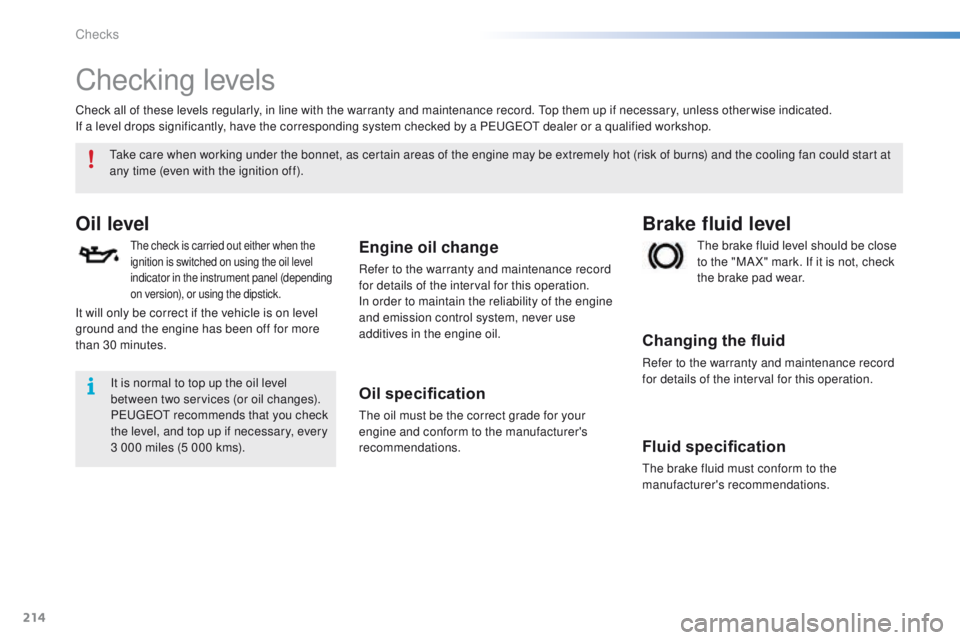
214
2008_en_Chap10_verifications_ed01-2015
Checking levels
Oil level
The check is carried out either when the
ignition is switched on using the oil level
indicator in the instrument panel (depending
on version), or using the dipstick.Engine oil change
Refer to the warranty and maintenance record
for details of the interval for this operation.
In order to maintain the reliability of the engine
and emission control system, never use
additives in the engine oil.
Oil specification
The oil must be the correct grade for your
engine and conform to the manufacturer's
recommendations.The brake fluid level should be close
to the "MA X" mark. If it is not, check
the brake pad wear.
Brake fluid level
Changing the fluid
Refer to the warranty and maintenance record
for details of the interval for this operation.
Fluid specification
The brake fluid must conform to the
manufacturer's recommendations.
Take care when working under the bonnet, as certain areas of the engine may be extremely hot (risk of burns) and the cooling fan could start at
any time (even with the ignition off).
Check all of these levels regularly, in line with the warranty and maintenance record. Top them up if necessary, unless other wise indicated.
If a level drops significantly, have the corresponding system checked by a PEUGEOT dealer or a qualified workshop.
It is normal to top up the oil level
between two services (or oil changes).
PEUGEOT recommends that you check
the level, and top up if necessary, every
3 000 miles (5 000 kms).
It will only be correct if the vehicle is on level
ground and the engine has been off for more
than 30 minutes.
Checks
Page 217 of 340
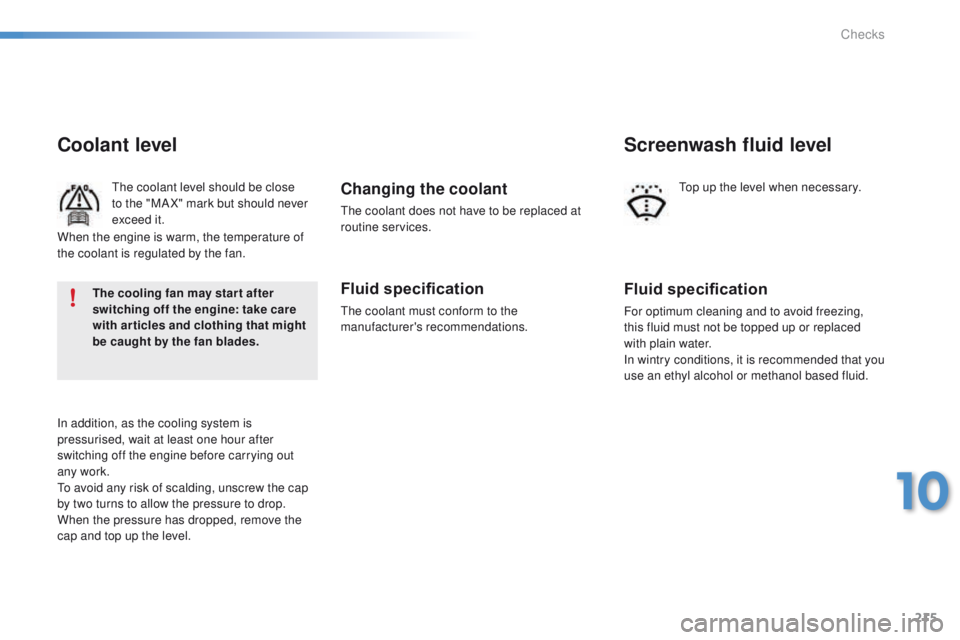
215
2008_en_Chap10_verifications_ed01-2015
Coolant level
The coolant level should be close
to the "MA X" mark but should never
exceed it.
In addition, as the cooling system is
pressurised, wait at least one hour after
switching off the engine before carrying out
any work.
To avoid any risk of scalding, unscrew the cap
by two turns to allow the pressure to drop.
When the pressure has dropped, remove the
cap and top up the level.Changing the coolant
The coolant does not have to be replaced at
routine services.
Fluid specification
The coolant must conform to the
manufacturer's recommendations.
Fluid specification
For optimum cleaning and to avoid freezing,
this fluid must not be topped up or replaced
with plain water.
In wintry conditions, it is recommended that you
use an ethyl alcohol or methanol based fluid.
Screenwash fluid level
Top up the level when necessary.
When the engine is warm, the temperature of
the coolant is regulated by the fan. The cooling fan may star t after
switching off the engine: take care
with articles and clothing that might
be caught by the fan blades.
10
Checks
Page 218 of 340
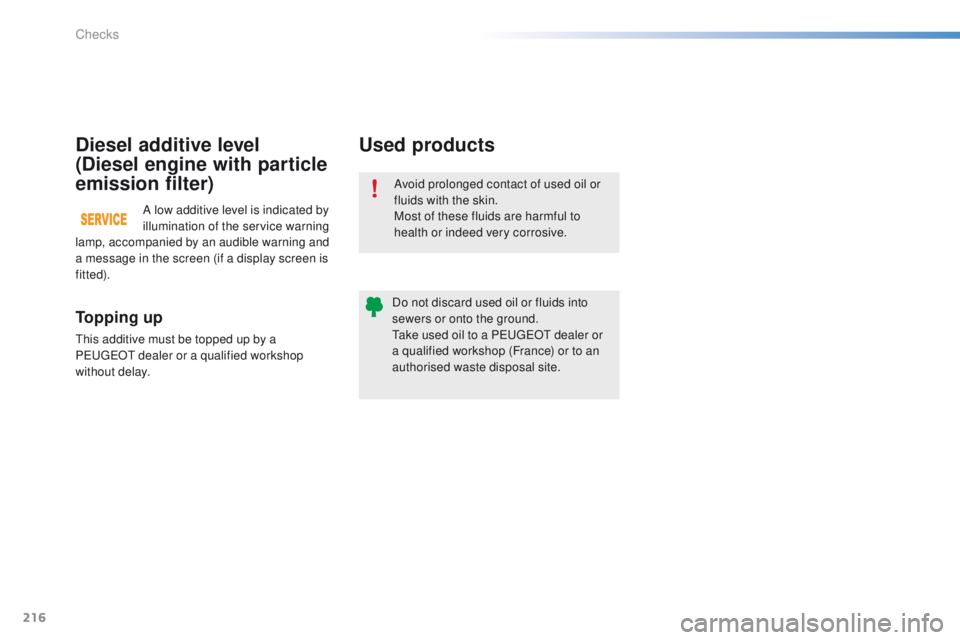
216
2008_en_Chap10_verifications_ed01-2015
Avoid prolonged contact of used oil or
fluids with the skin.
Most of these fluids are harmful to
health or indeed very corrosive.
Do not discard used oil or fluids into
sewers or onto the ground.
Take used oil to a PEUGEOT dealer or
a qualified workshop (France) or to an
authorised waste disposal site.
Used products
To p p i n g u p
This additive must be topped up by a
PEUGEOT dealer or a qualified workshop
without delay.
Diesel additive level
(Diesel engine with particle
emission filter)
A low additive level is indicated by
illumination of the service warning
lamp, accompanied by an audible warning and
a message in the screen (if a display screen is
fitted).
Checks
Page 219 of 340
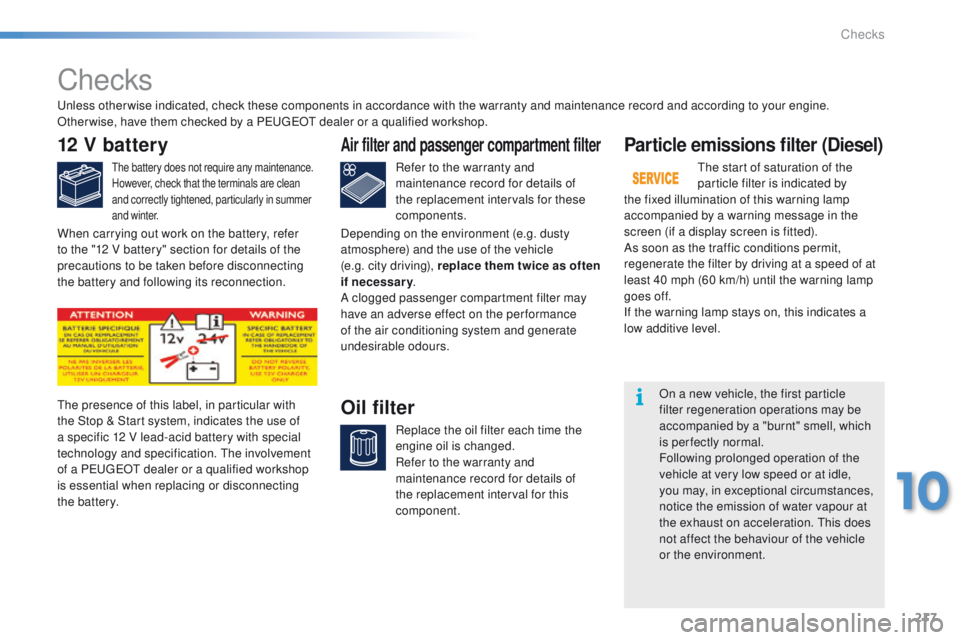
217
2008_en_Chap10_verifications_ed01-2015
Checks
12 V battery
The battery does not require any maintenance.
However, check that the terminals are clean
and correctly tightened, particularly in summer
and winter.
The presence of this label, in particular with
the Stop & Start system, indicates the use of
a specific 12 V lead-acid battery with special
technology and specification. The involvement
of a PEUGEOT dealer or a qualified workshop
is essential when replacing or disconnecting
the battery.
Particle emissions filter (Diesel)
The start of saturation of the
particle filter is indicated by
the fixed illumination of this warning lamp
accompanied by a warning message in the
screen (if a display screen is fitted).
As soon as the traffic conditions permit,
regenerate the filter by driving at a speed of at
least 40 mph (60 km/h) until the warning lamp
goes off.
If the warning lamp stays on, this indicates a
low additive level.
On a new vehicle, the first particle
filter regeneration operations may be
accompanied by a "burnt" smell, which
is perfectly normal.
Following prolonged operation of the
vehicle at very low speed or at idle,
you may, in exceptional circumstances,
notice the emission of water vapour at
the exhaust on acceleration. This does
not affect the behaviour of the vehicle
or the environment.
Unless other wise indicated, check these components in accordance with the warranty and maintenance record and according to your engine.
Other wise, have them checked by a PEUGEOT dealer or a qualified workshop.
Air filter and passenger compartment filter
Refer to the warranty and
maintenance record for details of
the replacement intervals for these
components.
Oil filter
Replace the oil filter each time the
engine oil is changed.
Refer to the warranty and
maintenance record for details of
the replacement interval for this
component.
When carrying out work on the battery, refer
to the "12 V battery" section for details of the
precautions to be taken before disconnecting
the battery and following its reconnection.
Depending on the environment (e.g. dusty
atmosphere) and the use of the vehicle
(e.g. city driving), replace them twice as often
if necessary
.
A clogged passenger compartment filter may
have an adverse effect on the per formance
of the air conditioning system and generate
undesirable odours.
10
Checks
Page 221 of 340
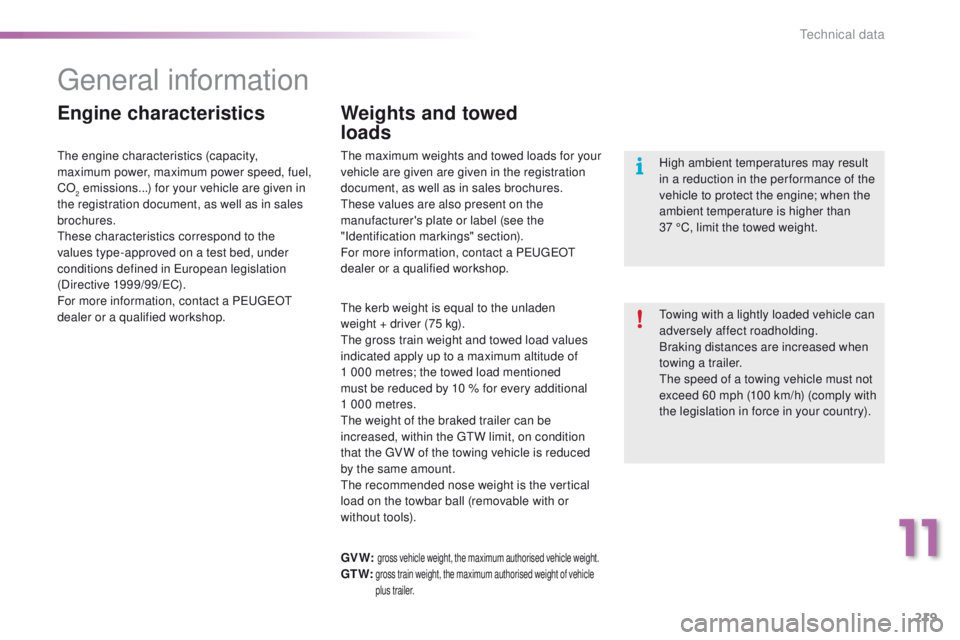
219
2008_en_Chap11_caracteristiques-techniques_ed01-2015
General information
Towing with a lightly loaded vehicle can
adversely affect roadholding.
Braking distances are increased when
towing a trailer.
The speed of a towing vehicle must not
exceed 60 mph (100 km/h) (comply with
the legislation in force in your country). High ambient temperatures may result
in a reduction in the per formance of the
vehicle to protect the engine; when the
ambient temperature is higher than
37 °C, limit the towed weight.
Engine characteristicsWeights and towed
loads
The engine characteristics (capacity,
maximum power, maximum power speed, fuel,
CO
2 emissions...) for your vehicle are given in
t
he registration document, as well as in sales
brochures.
These characteristics correspond to the
values type-approved on a test bed, under
conditions defined in European legislation
(Directive
1999/99/EC).
For more information, contact a PEUGEOT
dealer or a qualified workshop. The maximum weights and towed loads for your
vehicle are given are given in the registration
document, as well as in sales brochures.
These values are also present on the
manufacturer's plate or label (see the
"Identification markings" section).
For more information, contact a PEUGEOT
dealer or a qualified workshop.
The kerb weight is equal to the unladen
weight
+ driver (75 kg).
The gross train weight and towed load values
indicated apply up to a maximum altitude of
1 000 metres; the towed load mentioned
must be reduced by 10 % for every additional
1
000 metres.
The weight of the braked trailer can be
increased, within the GTW limit, on condition
that the GV W of the towing vehicle is reduced
by the same amount.
The recommended nose weight is the vertical
load on the towbar ball (removable with or
without tools).
GV W:
gross vehicle weight, the maximum authorised vehicle weight.GT W: gross train weight, the maximum authorised weight of vehicle plus trailer.
11
Technical data
Page 222 of 340
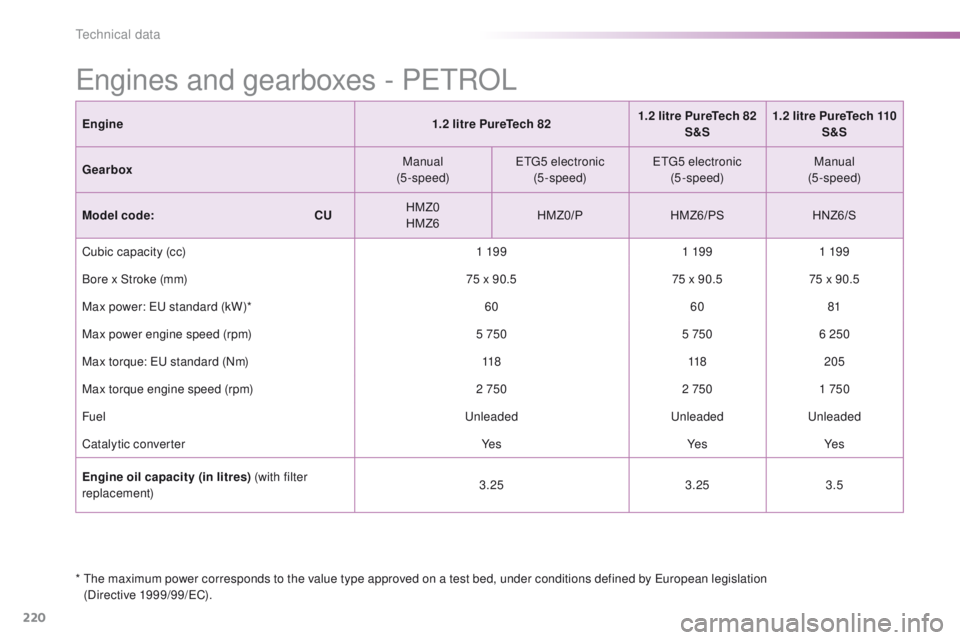
220
2008_en_Chap11_caracteristiques-techniques_ed01-2015
Engines and gearboxes - PETROL
* The maximum power corresponds to the value type approved on a test bed, under conditions defined by European legislation (Directive 1999/99/EC).
Engine
1.2 litre PureTech 821.2 litre PureTech 82
S&S 1.2 litre PureTech 110
S&S
Gearbox Manual
(5-speed) ETG5 electronic
(5-speed) ETG5 electronic
(5-speed) Manual
(5-speed)
Model code:
C
U
HMZ0
HMZ6 HMZ0/P
HMZ6/PS HNZ6/S
Cubic capacity (cc) 1 19 91 19 91 19 9
Bore x Stroke (mm) 75 x 90.575 x 90.575 x 90.5
Max power: EU standard (kW)* 606081
Max power engine speed (rpm) 5 7505 7506 250
Max torque: EU standard (Nm) 118118205
Max torque engine speed (rpm) 2 7502 7501 750
Fuel UnleadedUnleadedUnleaded
Catalytic converter Ye sYe sYe s
Engine oil capacity (in litres) (with filter
replacement) 3.25
3.253.5
Technical data
Page 223 of 340
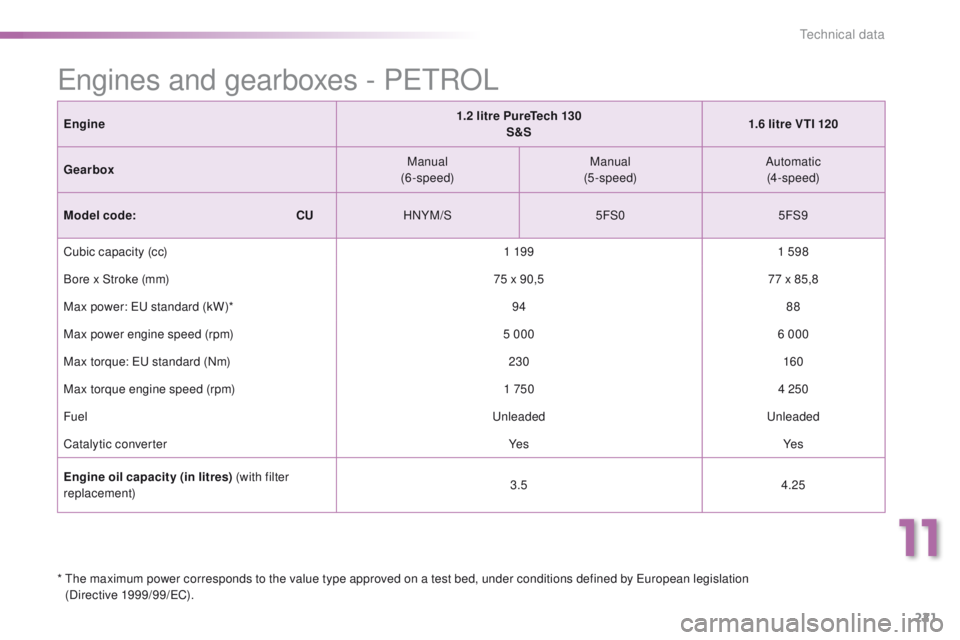
221
2008_en_Chap11_caracteristiques-techniques_ed01-2015
Engine1.2 litre PureTech 130
S&S 1.6 litre VTI 120
Gearbox Manual
(6-speed) Manual
(5-speed) Automatic
(4-speed)
Model code:
C
UHNYM/S 5FS05FS9
Cubic capacity (cc) 1 19 91 598
Bore x Stroke (mm) 75 x 90,577 x 85,8
Max power: EU standard (kW)* 9488
Max power engine speed (rpm) 5 0006 000
Max torque: EU standard (Nm) 230160
Max torque engine speed (rpm) 1 7504 250
Fuel UnleadedUnleaded
Catalytic converter Ye sYe s
Engine oil capacity (in litres) (with filter
replacement) 3.5
4.25
Engines and gearboxes - PETROL
* The maximum power corresponds to the value type approved on a test bed, under conditions defined by European legislation
(Directive 1999/99/EC).
11
Technical data